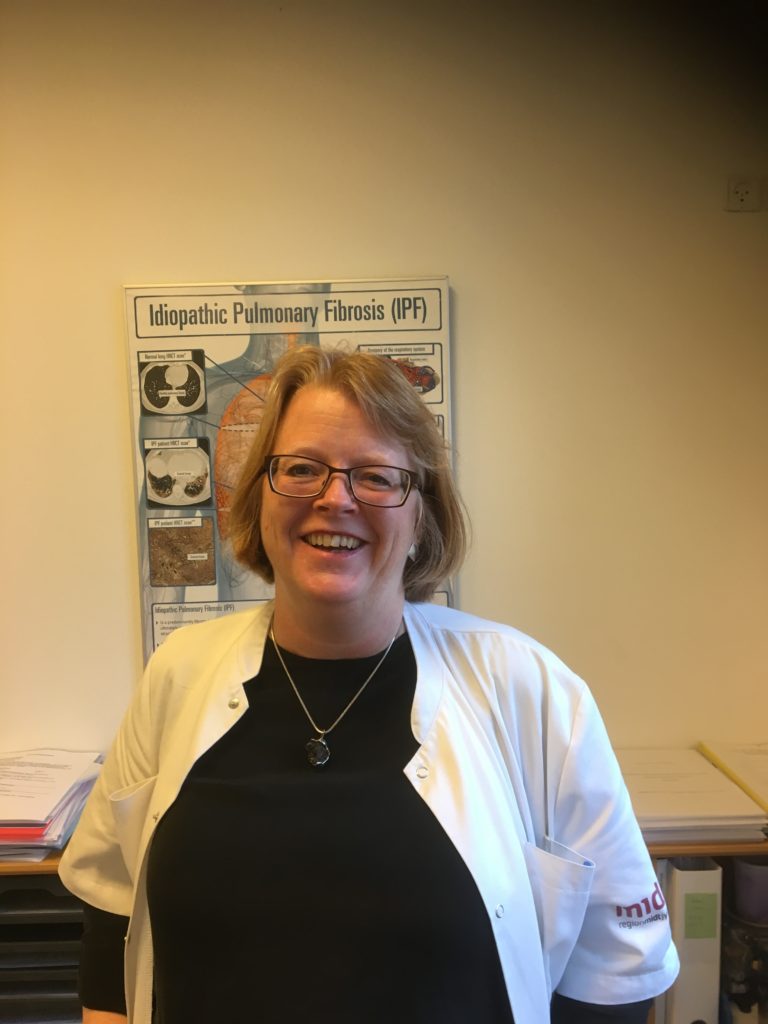
Interview with dr. Elisabeth Bendstrup
Dr. Elisabeth Bendstrup is associate professor and specialist in respiratory medicine in the Danish Aarhus University Hospital. Working in this large center for interstitial lung diseases (ILDs) has made her an expert in this field. Bendstrup is convinced that idiopathic pulmonary fibrosis (IPF), a specific form of ILD, is never a ‘stable’ disease and strives for more awareness of this illness. ‘We try to teach our colleagues that this is a very progressive, deadly disease that you need to identify and treat as soon as possible.’
The care for ILDs in Denmark is concentrated in a few specialized centers. ‘We are the largest ILD-center in Denmark’, says Bendstrup. ‘We see around 500 new ILD patients each year and about 25 patients each day.’ According to Bendstrup, it’s a very good idea to concentrate the care of ILD. ‘ILDs are very complicated diseases and you need experience with them to treat them well. If you for example see only three ILD patients a year, it’s very difficult to keep up your experience and knowledge of these rare diseases.’
Like a detective
One of the things Bendstrup likes about treating patients with ILDs, is that the diseases are very daunting and challenging. ‘I love a challenge. With ILDs, you really have to put your brain to work. It’s like being a detective, exploring for information and knowledge about rare diseases. It’s also an area in which you can make a huge difference for patients. Quite often, patients come in after they have been to several physicians already, and they don’t know anything about their disease. So we can give the detailed information and explanation about their disease and the possibilities for treatment. Patients are relieved to finally have a diagnosis and thorough knowledge about their perspective. That’s very satisfying for both patients and caregivers.’
Scarring of the lungs
One of the most common forms of ILD, is IPF. ‘With IPF, there is a continuous progression of scar tissue in the lungs’, Bendstrup explains. ‘And the more scar tissue, the less normal lung tissue you have. So you start to get difficulties breathing and you get more and more tired, due to the extra respiratory effort made.’ Luckily, recently medicines have been developed that can slow this scarring down, so-called antifibrotics. ‘But they can only slow it down’, Bendstrup says. ‘It’s important to realize that IPF is not a stable disease. So we try to focus on that and stress to our colleagues that IPF is in fact a very progressive, deadly disease that you need to identify as soon as possible, so we can start the treatment as soon as possible. Because lung tissue which is lost to scarring, can never be regained or repaired. You should also be treating IPF as long as possible. We only stop with antifibrotics in the case of intolerable side effects, or when patients are in the end-of-life period.’
Fitness and physical training
While antifibrotics can slow IPF down, there are also multiple things a patients can do theirselves to feel better. ‘Physical training is extremely important’, Bendstrup says. ‘Try to stay as fit as possible. Even a small training, with little effort, is worthwhile. Also, do whatever you can to prevent infections. Get your flu immunization and avoid being around people that have fever, flu or are wheezing and coughing. Wash your hands with soap. Infections are often the cause of exacerbations, which have a very high mortality. And don’t be scared of oxygen treatment, when you’re at the stage that it’s needed. Use the oxygen, see it as a wheelchair for your lungs.’
All in all, Bendstrup is modestly optimistic about the treatment of IPF. ‘We can identify a lot more patients than 5 to 10 years ago, because there is more knowledge about ILD and diagnostic tests, such as spirometry and HRCT scans, are performed more often. And of course, we now have access to two evidence-based drugs that have been approved for use in ILD. It’s not enough, but it’s a good step forward. And we keep doing a lot of research. We are all dedicated and driven and excited about the possibilities in this field. There is still so much unknown, a lot of unexplored territory, so you can really make a difference.’
Dit interview is geschreven voor Belung Magazine, een uitgave van Boehringer Ingelheim
